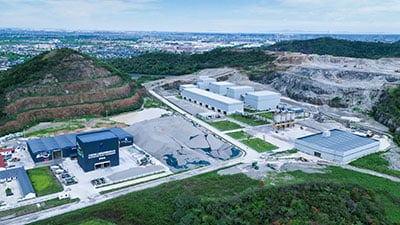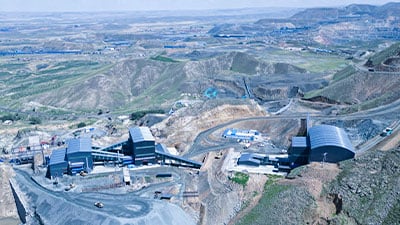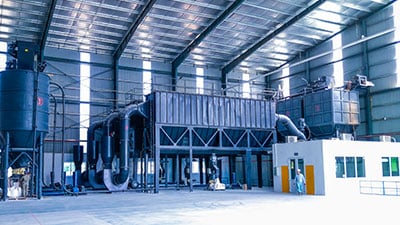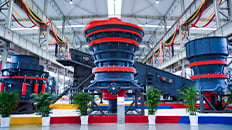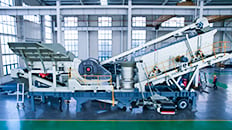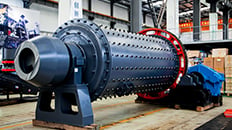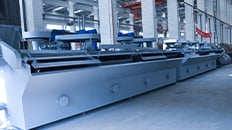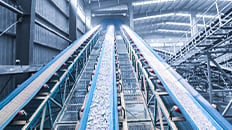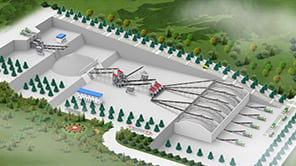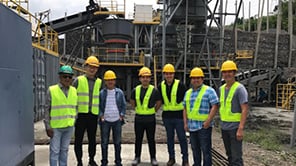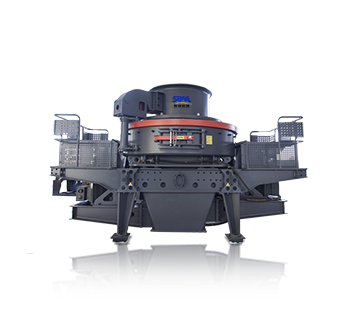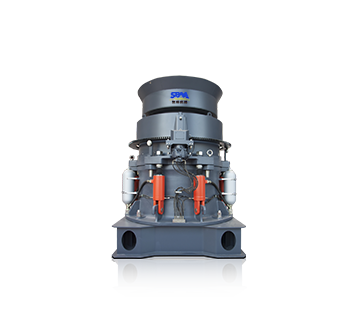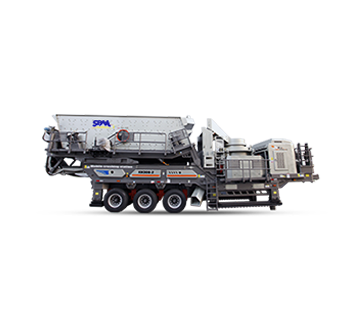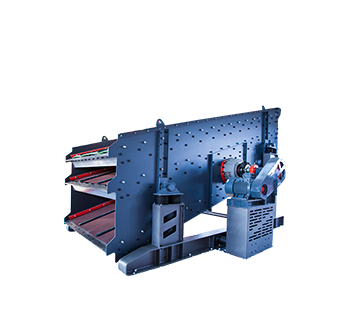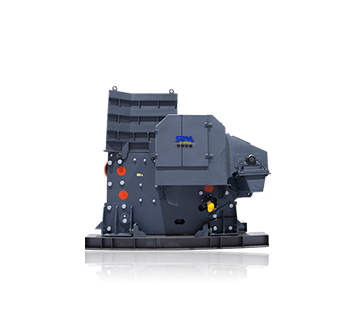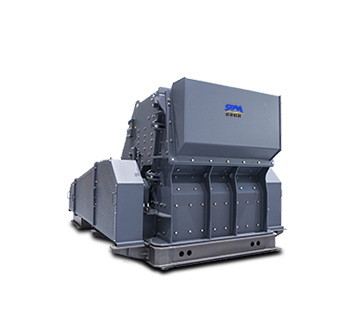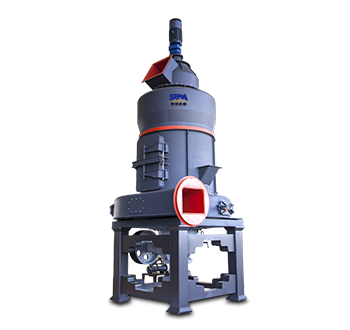Summary:Sand and gravel aggregate plants are used to produce high quality aggregate for construction purposes. While these plants are designed to operate smoothly, there are some common problems that can occur
Sand and gravel aggregate plants are used to produce high quality aggregate for construction purposes. While these plants are designed to operate smoothly, there are some common problems that can occur. Here are some of the Frequent problems and solutions in the aggregate production process.

1. Quality control of raw material
- Rock, ore, tailings
Before mining raw materials, it is necessary to remove the top cover layer of the material yard and ensure that the surface of the mining layer has no grass roots, covering soil, and other substances. When cleaning the covering layer, try to ensure that it is completed one time, and a certain width of the protective zone needs to be left to avoid the vibration generated during the mining of raw materials, which may cause the covering soil at the boundary to slide off and mix with the raw materials again.
- Construction waste, waste concrete blocks etc.
Construction waste raw materials are recommended to be pretreated first, including manual sorting of large decoration waste and the use of hydraulic hammer to reduce the bulk material. After sorting and removing large debris, crushing and screening the construction waste to separate miscellaneous soil, and c separate iron and steel and iron products in the construction waste through an iron remover, which can ensure the quality of finished products.
2. Mud content control
The control of mud content in finished sand and gravel aggregates includes source control, system processing technology control, and production organization measures.
The source control mainly involves organizing the construction of the material yard reasonably, strictly distinguishing between weakly weathered and strongly weathered boundaries, and treating strongly weathered materials as waste materials.
System processing process control: In dry production, the trace amount of mud in the coarsely crushed rock is separated and processed, and particles of 0-200mm are screened out. In wet production, multi-stage washing machines are generally designed and specialized cleaning equipment is set up to effectively ensure that the mud content of the aggregate meets the standard.
The production organization measures mainly are: prohibit unrelated equipment and personnel from entering the finished product storage yard; The surface of the stacking site should be flat, with appropriate slopes and drainage facilities; For large storage yards, the ground should be covered with clean material with a particle size of 40-150mm and a compacted stone cushion layer; The storage time of finished products should not be too long.
3. Stone powder content control
Appropriate stone powder content can improve the workability of concrete, enhance its compactness, and is beneficial for improving its performance.
In the dry method production process, the stone powder content of manufactured sand is generally high. Different screens can be replaced according to the requirements of different construction for stone powder to achieve control of the stone powder content.
The stone powder content of manufactured sand in the wet method production process is generally low, and most projects require the recovery of some stone powder to meet the needs of the project. In order to effectively control the content of stone powder, the following measures are often taken:
- Effectively control the amount of stone powder added through continuous testing.
- Attach a vibrator to the wall of the stone powder adding hopper, and install a spiral classifier below the hopper. The stone powder is evenly added to the finished sand storage belt conveyor through spiral classifier to achieve a uniform mixing of stone powder.
- The wastewater treatment workshop should be located as close as possible to the finished sand belt conveyor, which can be used for smooth transportation. After being dried by the filter press, the stone powder is processed into loose powder by the crusher to prevent the stone powder from forming clumps.
- In the overall construction layout, a stone powder storage yard should be considered, which can adjust the addition amount and reduce the water content of the finished sand through natural dehydration to a certain extent.
4. Control of needle and flake particles content
The quality control measures for the needle and flake particles content of coarse aggregate mainly rely on the selection of equipment, followed by adjusting the block size of the feeding materials in the production process.
Due to the different mineral composition and structure of various raw materials, the particle size and grading of the crushed raw materials are also different. The hard quartz sandstone and various intrusive igneous rocks have the worst grain size, with a large amount of needle flakes, while the medium hardness limestone and dolomitic limestone have a small amount of needle flakes.
A large number of experiments prove that different crushers have different effects on producing needle flake particles content. The needle flake particles content of coarse aggregate produced by jaw crusher is slightly higher than that produced by cone crusher.
The needle flake content of coarse crushing is greater than that of medium crushing, and the needle flake content of medium crushing is also greater than that of fine crushing. The higher the crushing ratio, the greater the content of needle like flakes. In order to improve the particle shape of the aggregate, reduce the block size before coarse crushing, and try to use the small and medium rocks after coarse crushing and medium crushing to make sand. The small and medium rocks after fine crushing should be used as the finished product of the coarse aggregate, which can also strictly control the needle flake particles content.
5. Moisture content control
In order to steadily reduce the moisture content to the specified range, the following measures are generally taken:
- Firstly, we can adopt mechanical dehydration. At present, the most commonly used is the vibrating screen dehydration process. After being dehydrated by a linear dehydration screen, the sand can be removed from the original moisture content of 20%-23% to 14%-17%; there are also vacuum dewatering and centrifugal dewatering that have good dewatering effects and correspondingly high investment costs.
- The storage dehydration and extraction of manufactured sand are carried out separately. Generally, after 3-5 days of storage dehydration, the moisture content can be reduced to within 6% and stable.
- Mixing dry method manufactured sand and dehydrated screen manufactured sand into the finished sand bin can reduce the water content of the sand.
- Install a rain shelter at the top of the finished sand bin, pour concrete floors at the bottom of the sand bin, and install blind ditch drainage facilities. The blind ditch shall be cleaned once after discharging materials in each bin to speed up the natural dehydration time and effectively reduce the moisture content of the finished sand.
6. Fineness modulus control
The finished sand should meet the requirements of hard texture, cleanliness, and good grading, for example, the fineness modulus of concrete sand should be 2.7-3.2. The following technical measures are usually used to control and adjust the fineness modulus of finished sand:
Firstly, the process is flexible and adjustable, with strict control during the production process. It is necessary to systematically and comprehensively debug the equipment, and optimize the configuration of the equipment by testing the composition data of yield and particle size. Therefore, in order to obtain stable and controllable fineness modulus, it is necessary to consider it systematically.
The second is to control the fineness modulus in steps or stages. The coarse crushing or secondary crushing process has slightly impact on the fineness modulus, but sand making, stone powder sorting, or cleaning stages have significant impact on the fineness modulus. Therefore, adjust and control the fineness modulus at this stage is very necessary and the effect is very obvious.
At present, vertical shaft impact crusher is the most commonly used sand making equipment. During the production process, the feed particle size, feed volume, linear speed, and the characteristics of the raw materials are directly related to the fineness modulus.
7. Environmental protection (dust pollution)
During the production process of manufactured sand, dust pollution is easy to occur due to the influence of dry materials, strong winds, and other surrounding environments. Here are some measures for dust pollution:
- Fully sealed
The environmentally friendly sand production equipment adopts a fully sealed structure design, with a strengthened dust removal design scheme. The dust removal rate can reach over 90%, and there is no oil leakage around the equipment, achieving environmental protection.
- Dust collector and fine sand recovery device
The selection of dust collector for dry method sand production process can effectively reduce dust pollution; A fine sand recovery device can also be installed, which can effectively reduce the loss of fine sand, which is very conducive to the recycling and utilization of tailings. At the same time, it can also increase the production of finished fine sand, improve efficiency and productivity value.
- Dust emission concentration tester
In order to successfully pass the environmental assessment and carry out normal production and business activities, users can also choose to install dust emission concentration tester to achieve safe and practical value.
- Hardened road surface and spray cleaning
The transportation road surface on the site should be hardened, and the transportation vehicles should be sealed; the sand stacking area cannot be changed arbitrarily; there should have spraying equipment, staff can be organized to spray and clean at intervals.

